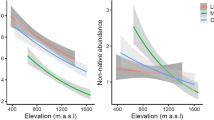
Overview
- Prescribes a novel methodology for analyzing the ecology of mountain systems
- Identifies the key determinants of plant richness in the Himalayas
- Discusses plant invasions and climate change impacts on the Himalayas
Access this book
Tax calculation will be finalised at checkout
Other ways to access
About this book
This book discusses plant invasions and environmental impacts on the Himalayas through a novel procedure, and helps to understand the influences of climate, physiography, soil, and disturbance on plant richness in mountain systems. Assessing invasion risks to mountain space under future climate change scenarios is highly significant for appropriate preparedness, and this book details analytical and modeling techniques to assess the conditions of mountain ecosystem and ecology to better inform our preparation for future environmental challenges. The book presents the state-of-the-art understanding of the species-environment relationships in a global biodiversity hotspot, relatively unexplored areas for the Himalayan life-form richness. The book provides not only the academic but also the professional community and policymakers a review and update on modeling applications for determining interactions of the plant species with the environment of a subtropical mountain ecosystem across a climatic gradient. Currently, there is no book in the market addressing the implementation and applications of modeling in the Himalayan plant and environment continuum, and most of the existing books cover the species richness pattern along the elevation gradient and basic ethnobotanical features of a mountain system. Since the book covers the applications of novel methods and modeling for ecological analysis of mountain ecosystems, it will also be significant for the professional market. Therefore, the book aims to fill the gap between scientists and professionals in the use of modeling strategies to monitor biodiversity in mountain systems for the formulation of conservation, adaptation, and mitigation principles.
Similar content being viewed by others
Keywords
Table of contents (6 chapters)
Authors and Affiliations
About the author
Dr. Rajendra Mohan Panda is an ecologist and modeling specialist with more than ten years of research experience in the fields of agriculture, biostatistics, ecology, forestry, and soil science. His broad research interests include biodiversity, climate change predictions, invasion risk assessments, spatial modeling, ecological monitoring, interactive mapping, and visualization. Rajendra has proficiencies in large spatial data analysis, species distribution modeling, machine learning, and R-software. He is a team leader with capabilities in managing Workshops and Conferences. Rajendra has more than twenty peer-reviewed publications in reputed journals and books, two of which have received media attention. Rajendra has also experience in teaching and mentoring M.Tech. and Ph.D. students.
Bibliographic Information
Book Title: Plant Ecology of Indian Himalaya
Authors: Rajendra Mohan Panda
DOI: https://doi.org/10.1007/978-3-031-13347-3
Publisher: Springer Cham
eBook Packages: Earth and Environmental Science, Earth and Environmental Science (R0)
Copyright Information: The Editor(s) (if applicable) and The Author(s), under exclusive license to Springer Nature Switzerland AG 2022
Hardcover ISBN: 978-3-031-13346-6Published: 29 September 2022
Softcover ISBN: 978-3-031-13349-7Published: 02 October 2023
eBook ISBN: 978-3-031-13347-3Published: 28 September 2022
Edition Number: 1
Number of Pages: XII, 172
Number of Illustrations: 7 b/w illustrations, 58 illustrations in colour
Topics: Physical Geography, Environment, general, Plant Sciences, Ecology



